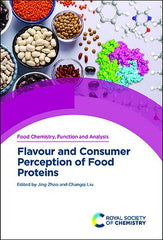Flavour and Consumer Perception of Food Proteins Edited by Jing Zhao; Changqi Liu
The United Nations predicted that the global population would reach 9.7 billion by 2050 and 10.4 billion by 2100. With this growth, there will be a heightened demand for high-quality proteins, as they are an essential nutrient and important food ingredient. Moreover, the rise in consumer awareness for health and fitness, increasing disposable income, growing demand from the millennial population for supplements, and the rise in popularity of alternative proteins as substitutes for meat and animal products are driving the growth of the protein ingredient market.
Many studies have investigated the functional properties of protein ingredients, such as their solubility, foaming, emulsification, gelation, water holding, and oil absorption properties. However, there is limited research on their flavour characteristics and protein–flavour interactions in different processing conditions and formulations. Certain proteins have distinct odours, hindering their widespread applications. For example, soy and pea proteins are often described as having a green, beany off-flavour by consumers. Profiling flavour compounds and removing or masking the off flavours are crucial for product development and quality control. This book provides consolidated information on the flavour of food protein ingredients and highlights areas for further research, serving as a resource for the food industry and researchers studying food proteins and flavours.
In this book, we use terms such as traditional proteins (from animal sources like meat, seafood, dairy, and eggs), plant/vegetable proteins (from plants like cereals, pseudocereals, and legumes), and novel proteins (from bacteria, fungi, algae, edible insects, and cultured meat) to describe food proteins from various sources. Leaf and oilseed proteins are grouped under novel proteins as they are not widely used.
- Cover
- Half title
- Series editors
- Title
- Copyright
- Preface
- Contents
- Chapter 1 Overview of Protein Flavours
- 1.1 Introduction
- 1.2 Protein Market Overview
- 1.2.1 Whey Protein Market
- 1.2.2 Plant Protein Market
- 1.2.3 Novel Protein Market
- 1.3 Sensory Impacts and Flavour of Food Proteins
- 1.3.1 Taste of Amino Acids and Protein Hydrolysates
- 1.3.2 Taste of Proteins
- 1.3.3 Odours of Proteins
- 1.4 Protein and Peptide as Flavour Precursors
- 1.4.1 Protein and Peptide as Precursors of Meat Flavours
- 1.4.2 Preparation of Maillard Reaction Products
- 1.4.3 Taste of Maillard Reaction Products
- 1.4.4 Aroma of Maillard Reaction Products
- 1.4.5 Applications of Maillard Reaction Products
- 1.5 Conclusions
- Abbreviations
- References
- Chapter 2 Consumer Perceptions of Food Proteins and Protein-enriched Foods
- 2.1 Introduction
- 2.2 Protein Concentrate, Isolate, and Hydrolysate
- 2.2.1 Whey Protein Concentrate, Isolate, and Hydrolysate
- 2.2.2 Online Consumer Reviews of Soy Protein Isolate Powders
- 2.2.3 Rice Protein Concentrate, Isolate, and Hydrolysate
- 2.3 Consumer Acceptance of Protein-based Foods
- 2.3.1 Protein Shakes and Beverages
- 2.3.2 Protein Bars
- 2.3.3 Animal Food Alternatives
- 2.4 Protein-enriched Foods
- 2.4.1 Meat Products
- 2.4.2 Dairy Products
- 2.4.3 Baked Foods
- 2.4.4 Snacks
- 2.4.5 Dessert
- 2.4.6 Wine and Beverages
- 2.4.7 Other Products
- 2.5 Consumer Studies on Novel Proteins
- 2.5.1 Algae Proteins
- 2.5.2 Cultured Alternative Products
- 2.6 Conclusion
- Abbreviations
- References
- Chapter 3 Chemical and Instrumental Characterization of Protein–Flavor Interactions
- 3.1 Introduction
- 3.2 Methods to Measure Reversible Protein–Flavor Interactions
- 3.2.1 Early Methods
- 3.2.2 Equilibrium Headspace Analysis
- 3.2.3 Headspace Solid-phase Microextraction
- 3.2.4 Headspace In-tube Extraction
- 3.2.5 Equilibrium Membrane Dialysis
- 3.2.6 Inverse Gas Chromatography and Radioisotopes
- 3.3 Irreversible Bonding
- 3.3.1 Default Methods
- 3.3.2 Vacuum Stripping
- 3.3.3 Indirect Methods
- 3.4 Direct Methods
- 3.4.1 Mass Spectrometry
- 3.5 Conclusions
- Abbreviations
- References
- Chapter 4 Flavor–Protein Binding on Flavor Delivery
- 4.1 Introduction
- 4.2 Types of Flavor–Protein Reactions
- 4.3 Reversible Bonds
- 4.3.1 Effect of Protein Type on the Formation of Reversible Bonds
- 4.3.2 Effect of the Chemical Properties of a Flavor Molecule on Flavor Binding
- 4.3.3 Effect of Protein Hydrolysis on Flavor Binding
- 4.3.4 Effect of Protein Heat Denaturation on Flavor Binding
- 4.3.5 Environment Effects on Flavor–Protein Binding
- 4.4 Irreversible Bonds (Covalent Bonding)
- 4.4.1 Protein–Flavor Covalent Reactions
- 4.4.2 Effect of Protein Type on the Formation of Flavor Bonding
- 4.4.3 Effect of the Chemical Properties of a Flavor Molecule on Flavor Binding
- 4.4.4 Environment Effects
- 4.5 Related Research
- 4.5.1 Metabolic Disruption by Protein: Small Molecule Reactions
- 4.5.2 Loss of Bioactivity via Reaction with Proteins
- 4.6 Summary
- Abbreviations
- References
- Chapter 5 The Flavour of Dairy Proteins
- 5.1 Introduction
- 5.2 Sources of Flavours in Milk and Dairy Products
- 5.3 Dairy Protein Flavours
- 5.4 Flavours of Major Dairy Protein Ingredients
- 5.4.1 Milk Concentrates: NDM and SMP
- 5.4.2 Milk Protein Concentrates and Isolates: MPC and MPI
- 5.4.3 Casein Proteins
- 5.4.4 Whey Proteins
- 5.5 Off-Flavours from Dairy Protein Ingredients
- 5.5.1 Off-aromas (Taints)
- 5.5.2 Off-tastes
- 5.6 Conclusion
- Abbreviations
- References
- Chapter 6 Flavour of Fish and Fish Proteins
- 6.1 Introduction
- 6.1.1 Fish Production and Consumption
- 6.1.2 Fish Production By-products
- 6.1.3 Fish Protein and Hydrolysates
- 6.2 Fish Flavour
- 6.2.1 Overview of Fish Flavour
- 6.2.2 Generation of Fish Flavour
- 6.2.3 Effect of Processing on the Volatiles
- 6.3 Characteristics and Bioactive Compounds of Fish Protein Products
- 6.4 Conclusion
- Abbreviations
- References
- Chapter 7 Soy Protein Flavours
- 7.1 Overview of SPI
- 7.1.1 Introduction of SPI
- 7.1.2 Applications and Limitations of SPI
- 7.2 Off-flavours
- 7.2.1 Off-flavours in SPI
- 7.2.2 Off-flavours in Soy Products
- 7.2.3 The Production of Off-flavours in SPI
- 7.2.4 Factors Affecting Off-flavours
- 7.3 Methods for Removal of the Off-flavours
- 7.3.1 The Cultivation of Soybean Varieties Without LOXs
- 7.3.2 Thermal Treatment
- 7.3.3 High-pressure Treatment
- 7.3.4 Irradiation Treatment
- 7.3.5 Biotic Elicitor Treatments
- 7.3.6 Ultrasound Treatment
- 7.3.7 Solvent Extraction Treatment
- 7.3.8 β -Cyclodextrin Treatment
- 7.3.9 Salting-out Treatment
- 7.4 Conclusion
- Abbreviations
- References
- Chapter 8 Pulse Protein Flavour
- 8.1 Introduction
- 8.2 Pulse Protein Profiles
- 8.2.1 Amino Acid Profile of Pulse Proteins
- 8.2.2 The Composition of Pulse Proteins
- 8.3 Preparation of Pulse Protein Extracts
- 8.3.1 Dry Processing
- 8.3.2 Wet Processing
- 8.3.3 Impact of Extraction Method on the Protein Flavours
- 8.4 Volatile Profiles of Pulse Proteins
- 8.4.1 Major Flavour Compounds in Pulse Proteins
- 8.4.2 Flavour Sources of Pulse Protein
- 8.4.3 The Interaction of Flavour Compounds and Proteins
- 8.5 Processing Technologies
- 8.5.1 Soaking
- 8.5.2 Boiling
- 8.5.3 Roasting
- 8.5.4 Extrusion
- 8.5.5 Germination
- 8.5.6 Fermentation
- 8.5.7 Others
- 8.6 Conclusion and Future Trends
- Abbreviations
- References
- Chapter 9 Flavour of Cereal and Pseudocereal Proteins
- 9.1 Introduction
- 9.2 True Cereals
- 9.2.1 Flavour of Corn Proteins
- 9.2.2 Flavour of Wheat Proteins
- 9.2.3 Flavour of Rice Proteins
- 9.2.4 Flavour of Barley and Barley Proteins
- 9.2.5 Flavour of Sorghum and Sorghum Proteins
- 9.2.6 Flavour of Millet Proteins
- 9.2.7 Flavour of Oat Proteins
- 9.3 Flavour of Pseudocereal Proteins
- 9.3.1 Flavour of Amaranth Proteins
- 9.3.2 Flavour of Buckwheat Proteins
- 9.3.3 Flavour of Chia Proteins
- 9.3.4 Flavour of Quinoa Proteins
- 9.4 Summary
- Abbreviations
- References
- Chapter 10 Flavour of Novel Food Proteins
- 10.1 Introduction
- 10.2 Flavour of Algal Proteins and Peptides
- 10.2.1 Flavour of Algae
- 10.2.2 Flavour of Algal Proteins
- 10.2.3 Flavour of Macroalgae Protein Hydrolysates
- 10.3 Flavour of Bacterial Proteins
- 10.4 Flavour of Fungal Proteins and Peptides
- 10.4.1 Flavour of Proteins from Filamentous Fungi
- 10.4.2 Flavour of Mushroom Proteins and Peptides
- 10.4.3 Flavour of Yeast Proteins and Peptides
- 10.5 Flavour of Insect Proteins and Peptides
- 10.6 Flavour of Leaf Proteins
- 10.7 Flavour of Oilseed Proteins
- 10.7.1 Flavour of Canola/Rapeseed Proteins and Peptides
- 10.7.2 Flavour of Cottonseed Proteins
- 10.7.3 Flavour of Flaxseed Protein Hydrolysates
- 10.7.4 Flavour of Hempseed Proteins
- 10.7.5 Flavour of Mustard Seed Proteins
- 10.7.6 Flavour of Sesame Proteins
- 10.7.7 Flavour of Sunflower Seed Protein Hydrolysates
- 10.8 Flavour of Tuber Proteins and Peptides
- 10.9 Flavour of Cultured Meat
- 10.10 Flavour Formation Catalysed by Leghaemoglobin
- 10.11 Concluding Remarks
- Abbreviations
- References
- Subject Index












